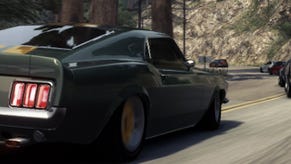GRID 2 multiplayer: giving racing lines the finger
GRID 2 developer Codemasters speaks with VG247's Dave Cook about its separate multiplayer campaign, squeezing everything out of current-gen tech, and the studio's future.
Racing games aren't just about speed and shiny cars any more. Back when Gran Turismo hit the scene there were few things as thrilling as bagging your A-Class license, or when you finally saved up enough to buy that Dodge Viper, only to realise it handled like it was permanently on ice. You know the one I mean.
Back then you couldn't really celebrate these milestones from the rooftops. I remember trading PSone memory cards with my mates back in the day to swap cars we had fine-tuned, or taking them to each other's houses to see whose car was faster. Hardly practical, but fun nonetheless.
Compare this to racing games of today, and you can see how far we've come in terms of multiplayer and socially-integrated play. Forza Horizon is a good example of rolling stat capture, where every little thing you do is turned into a competitive element for all to see.
You can brag about your best times or car set-ups in a few button presses using Need for Speed: Most Wanted's Autolog feed, or share photos of your best rides in Gran Turismo 5. We're all constantly competing with each other now, and these tools drive progression to a whole new level.
Codemasters wants to go even further than this in GRID 2. Not only has the UK-based team expanded its RaceNet social hub, it's crafted a separate multiplayer campaign for online racers to really sink their teeth into. It's an event unto itself, with several game modes that will test the skill of players to the utter limit.
"Multiplayer stands on its own two feet with an XP and cash progression system," senior games designer Ross Gowing told me. "Players will start with a small number of cars we've gifted them, then it's up to them how they want to fill out their garage, upgrade and customise their cars as they go.
"We serve up some great locations and circuits on our rolling online playlists, so they can just dive straight in, or they can set up custom events in a manner of their choosing. Then we have RaceNet challenges, which are a set of nine events that refreshes on a weekly basis, and then there's our Rivals system."
The Rivals system is interesting as each week it will pair you up with someone based anywhere in the world of a similar skill level, and hurl challenges at you via RaceNet. So even if you don't have a well-stocked friends list of fellow GRID 2 players, there's always someone around to destroy online.
Gowing explained that dedicated fans of the first GRID felt solo play and multiplayer should be isolated features in the sequel. Sometimes you do just want to hammer AI opponents and get lost in car set-ups for hours without social feeds assaulting your eyes with challenges constantly. The team agreed.
Don't worry about a diminished single player experience however, as GRID 2's offline campaign has taken some test players over 30 hours to complete at 100% and even then that was a generous estimate on Gowing's part.
He added, "We've noticed a trend in recent years with some of the supposedly 'big' games that were actually six hours long, and we didn't feel that was sufficient value for money for our fans at all. We wanted to make sure there was so much more for them to do."
To be fair Gowing isn't sugar-coating anything. Aside from that mammoth solo campaign the multiplayer is broken down into everything I've already mentioned above, then splintered off across many game modes. The most intriguing strain of events uses a new piece of tech called LiveRoutes and it - like almost everything new in GRID 2 - came from community feedback.
"LiveRoutes is something we've worked hard on," Gowing explained. "Where we take the layout of a city and all the routes we have going through there, and basically sections of the track will switch out ahead of you. So before you get to them, a different set of corners will appear over what you had during the last lap.
"Racing is more about who is the best moment-to-moment driver, who reacts to what is coming up ahead of them, rather than being able to memorise everywhere you're able to cut corners and such."
LiveRoutes makes perfect sense, as multiplayer racing games can become quite mundane once everyone has figured out the perfect racing line, devolving the experience into a something of a connect-the-dots exercise. In essence GRID 2 multiplayer will feature millions of track combinations as a result, ensuring that there is no one 'win-all' strategy.
Senior executive producer Clive Moody added, "There was an internal comment that somebody made a couple of days ago, where they had been playing the game a lot throughout development and they were playing a LiveRoutes event in Paris. Despite the fact they had played the game a lot, the experience completely pressured them with a whole new level of depth.
"That's what LiveRoutes sets out to do by giving you that unpredictability within the game, where you can't learn the tracks as it's always serving up something fresh. Given the combinations we can generate the chances of you playing the same route twice is pretty slim, but even if you did you probably wouldn't remember it anyway."
It's a neat system that goes hand-in-hand with all of the technical advancements made at Codemasters since the first GRID launched in 2008. While it's launching on the cusp of next-gen, GRID 2 is releasing now because the team felt that development tech had finally caught up with what it wanted to achieve.
Moody continued, "Right off the back of the first game's launch we already had a stack-load of ideas of where we wanted to take the game. But the reality was although we had great technology at that time, it just wasn't matured and developed enough to let us deliver against our ambition.
"So we took our time and let our tech guys develop great new systems. We were lucky to have been given the time to get to a place where we could deliver something which - we believe - way exceeds what the first experience gave, and I think gamers will really appreciate that."
Gowing added, "The question we ask ourselves daily is 'What can we do to raise our standards higher and higher?' There's already a stack of things building up on what we want to do in the future. We're thinking about next-gen, what that will bring, in addition to what we're already offering.
"We're thinking about how we can expand, how we can refine, and listening to what our fans want, then delivering on that to the absolutely highest standard. That's where our focus always lies."
GRID 2 launches on PC, PS3 and Xbox 360 across North American from May 28, and across Europe from May 31.





















